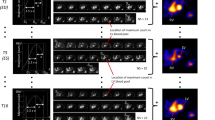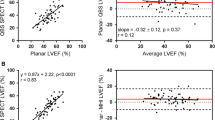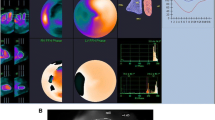Abstract
Background
We evaluated the accuracy of planar radionuclide angiography and different count-based and space-based electrocardiogram (ECG)-gated blood-pool single-photon emission computed tomography (GBPS) algorithms for assessment of left ventricular end-diastolic volume (LVEDV), end-systolic volume (LVESV), and ejection fraction (LVEF) compared with the gold standard of cardiac magnetic resonance imaging (cMRI). The goal is to assess the accuracy of a recently developed GBPS algorithm.
Methods and Results
Subjects had planar, GBPS, and cMRI sequentially. Datasets were processed by QBS software (Cedar-Sinai) and by MHI software (Montreal Heart Institute). Space-based approaches were used to compute LVEDV, LVESV, and LVEF. Count-based techniques were also used to assess LVEF. All results were compared to cMRI. Fifty-five patients (85% male; mean age 63 ± 9 years) completed the study. LVEFs and their correlations to cMRI values were 43 ± 12% (r = .82), 39 ± 14% (r = .82), and 39 ± 13% for MHIspace, QBSspace, and cMRI methodologies, respectively. LVEF by count-based methods also demonstrated good correlation to LVEF provided by cMRI (42 ± 13%, r = .88 for MHIcount and 46 ± 15%, r = .84 for QBScount). Strong correlations were obtained for LVEDV (r = .96 for MHI and r = .92 for QBS) and for LVESV (.97 for MHI and r = .94 for QBS).
Conclusions
All Gated blood-pool SPECT algorithms had significant variation in estimating LVEF. Nevertheless our software provides good estimates of LV volumes and LVEF. Such software may, therefore, be applied to assess LV morphology and function.



Similar content being viewed by others
References
Strauss HW, Zaret BL, Hurley PJ, Natarajan TK, Pitt B. A scintiphotographic method for measuring left ventricular ejection fraction in man without cardiac catheterization. Am J Cardiol 1971;28:575-80.
Zaret BL, Strauss HW, Hurley PJ, Natarajan TK, Pitt B. A noninvasive scintiphotographic method for detecting regional ventricular dysfunction in man. N Engl J Med 1971;284:1165-70.
Borow KM, Green LH, Mann T, Sloss LJ, Braunwald E, Collins JJ, et al. End-systolic volume as a predictor of postoperative left ventricular performance in volume overload from valvular regurgitation. Am J Med 1980;68:655-63.
Taniguchi K, Nakano S, Hirose H, Matsuda H, Shirakura R, Sakai K, et al. Preoperative left ventricular function: Minimal requirement for successful late results of valve replacement for aortic regurgitation. J Am Coll Cardiol 1987;10:510-8.
White HD, Norris RM, Brown MA, Brandt PW, Whitlock RM, Wild CJ. Left ventricular end-systolic volume as the major determinant of survival after recovery from myocardial infarction. Circulation 1987;76:44-51.
Stellbrink C, Breithardt OA, Franke A, Sack S, Bakker P, Auricchio A, et al. Impact of cardiac resynchronization therapy using hemodynamically optimized pacing on left ventricular remodeling in patients with congestive heart failure and ventricular conduction disturbances. J Am Coll Cardiol 2001;38:1957-65.
Yu CM, Fung WH, Lin H, Zhang Q, Sanderson JE, Lau CP. Predictors of left ventricular reverse remodeling after cardiac resynchronization therapy for heart failure secondary to idiopathic dilated or ischemic cardiomyopathy. Am J Cardiol 2003;91:684-8.
Notabartolo D, Merlino JD, Smith AL, DeLurgio DB, Vera FV, Easley KA, et al. Usefulness of the peak velocity difference by tissue Doppler imaging technique as an effective predictor of response to cardiac resynchronization therapy. Am J Cardiol 2004;94:817-20.
Pitzalis MV, Iacoviello M, Romito R, Massari F, Rizzon B, Luzzi G, et al. Cardiac resynchronization therapy tailored by echocardiographic evaluation of ventricular asynchrony. J Am Coll Cardiol 2002;40:1615-22.
El-Maghraby TA, El-Rahman NA. Clinical relevance of left ventricular volumes and function assessed by gated SPECT in paediatric patients. Int J Cardiovasc Imaging 2004;20:127-34.
Ford PV, Chatziioannou SN, Moore WH, Dhekne RD. Overestimation of the LVEF by quantitative gated SPECT in simulated left ventricles. J Nucl Med 2001;42:454-9.
Hambye AS, Vervaet A, Dobbeleir A. Variability of left ventricular ejection fraction and volumes with quantitative gated SPECT: Influence of algorithm, pixel size and reconstruction parameters in small and normal-sized hearts. Eur J Nucl Med Mol Imaging 2004;31:1606-13.
Nakajima K, Taki J, Higuchi T, Kawano M, Taniguchi M, Maruhashi K, et al. Gated SPET quantification of small hearts: Mathematical simulation and clinical application. Eur J Nucl Med 2000;27:1372-9.
Harel F, Finnerty V, Gregoire J, Thibault B, Khairy P. Comparison of left ventricular contraction homogeneity index using SPECT gated blood pool imaging and planar phase analysis. J Nucl Cardiol 2008;15:80-5.
Harel F, Finnerty V, Ngo Q, Gregoire J, Khairy P, Thibault B. SPECT versus planar gated blood pool imaging for left ventricular evaluation. J Nucl Cardiol 2007;14:544-9.
Van Kriekinge SD, Berman DS, Germano G. Automatic quantification of left ventricular ejection fraction from gated blood pool SPECT. J Nucl Cardiol 1999;6:498-506.
Kohonen T. Self-organized formation of topologically correct feature maps. Biol Cybern 1982;43:59-69.
Bland JM, Altman DG. Statistical methods for assessing agreement between two methods of clinical measurement. Lancet 1986;1:307-10.
Alfakih K, Plein S, Thiele H, Jones T, Ridgway JP, Sivananthan MU. Normal human left and right ventricular dimensions for MRI as assessed by turbo gradient echo and steady-state free precession imaging sequences. J Magn Reson Imaging 2003;17:323-9.
Bogaert JG, Bosmans HT, Rademakers FE, Bellon EP, Herregods MC, Verschakelen JA, et al. Left ventricular quantification with breath-hold MR imaging: Comparison with echocardiography. MAGMA 1995;3:5-12.
Qin JX, Jones M, Shiota T, Greenberg NL, Tsujino H, Firstenberg MS, et al. Validation of real-time three-dimensional echocardiography for quantifying left ventricular volumes in the presence of a left ventricular aneurysm: In vitro and in vivo studies. J Am Coll Cardiol 2000;36:900-7.
Acknowledgement
This work was supported in part by the “Fonds de la Recherche en Santé du Québec” and by a Canada Research Chair.
Author information
Authors and Affiliations
Corresponding author
Rights and permissions
About this article
Cite this article
Harel, F., Finnerty, V., Grégoire, J. et al. Gated blood-pool SPECT versus cardiac magnetic resonance imaging for the assessment of left ventricular volumes and ejection fraction. J. Nucl. Cardiol. 17, 427–434 (2010). https://doi.org/10.1007/s12350-010-9195-5
Received:
Accepted:
Published:
Issue Date:
DOI: https://doi.org/10.1007/s12350-010-9195-5




